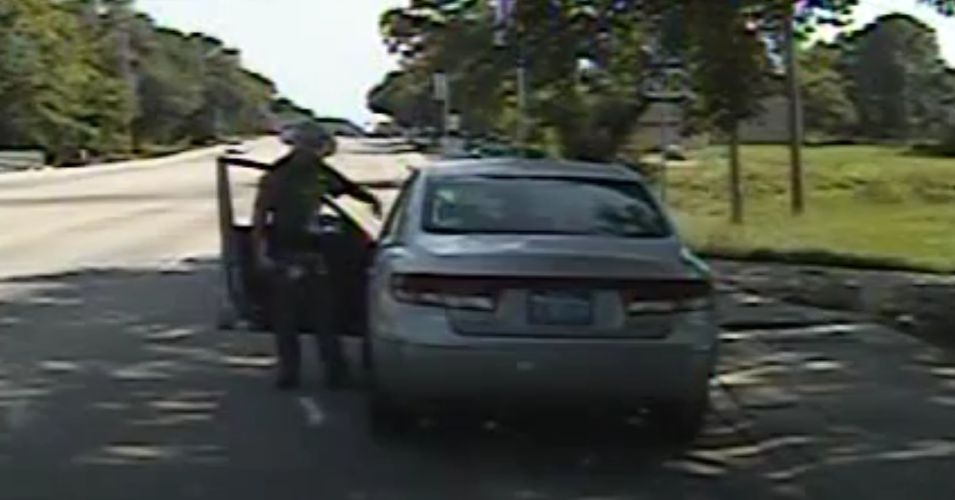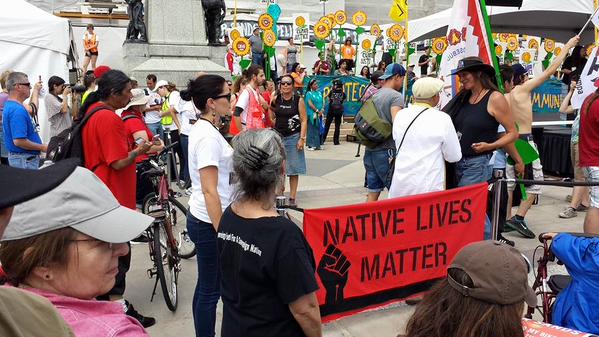Betraying arrest report, newly released footage shows how arresting officer violently escalating traffic stop by threatening unarmed black woman with Taser
Written by Jon Queally, staff writer for Common Dreams. Published 7-21-15.

In one shocking moment, the officer, tells Bland that if she does not get out of her car he will “light her up.” Subsequently, after she objects to having her head banged against the ground and telling him that she suffers from epilepsy, Encinia responds by saying, “Good.” (Image: Screenshot/Youtube)
While many questions still remain about what exactly happened to Sandra Bland in a Texas jail cell before she was found dead under mysterious circumstances on July 13, those looking for answers about why she was initially placed under arrest three days earlier were offered a look at devastating dash-cam footage released by the Texas Department of Public Safety on Tuesday evening which showed the arresting officer, Texas State Trooper Brian Encinia, actively escalating a situation with violence and threatening the unarmed black woman with a Taser.
The manner in which the escalation occurred led law enforcement officials to say that Encinia had not followed department procedures and failed to “maintain professionalism” during the arrest.
In one shocking moment, the officer, tells Bland that if she does not get out of her car he will “light her up.” Subsequently, after she objects to having her head banged against the ground and telling him that she suffers from epilepsy, Encinia responds by saying, “Good.”
As the New York Times reports, several Texas lawmakers who were shown the footage said it is clear that Bland should never have been treated in such a manner nor ultimately taken into custody by police. “This young woman should be alive today,” said State Representative Helen Giddings, Democrat of Dallas.
According to the Times:
Ms. Bland, an African-American from the Chicago area who had come to Texas for a job at her alma mater, Prairie View University, was arrested after she was stopped July 10 for a failure to signal a turn.
The video also confirmed an account from the family’s lawyer that the confrontation between Ms. Bland and the trooper, Brian T. Encinia, escalated after she refused the officer’s order to put out a cigarette, said [State Senator Royce West, Democrat of Dallas].
Neither the Taser nor the confrontation over the cigarette were mentioned in Officer Encinia’s incident report, which was released on Tuesday by the Waller County district attorney’s office.
Watch the footage [Warning: Graphic and strong language]:
https://youtu.be/yf8GR3OO9mU
Mother Jones reports:
In a press conference late Tuesday, the director of the Texas Department of Public Safety said that Encinia failed to “maintain professionalism” throughout his interaction with Bland, and that he has been taken off the street and placed on administrative duty for duration of the investigation into Bland’s death. In answer to a reporter’s question, Texas state Sen. Royce West said that the dash cam footage showed that Bland should not have been taken into police custody.
The subsequent death of Bland has continued to raise troubling questions since she was found hanged on the morning of July 13. A medical examiner report and the county sheriff’s office ruled her death a suicide, but during the three days Bland spent in jail, Bland’s family members said they spoke to her on the about posting bail, and that a suicide seemed “unfathomable.” An hour before she was found, Bland had asked to use the phone again, county officials said.
On Monday, officials in Waller County released additional details about the morning Bland died, including surveillance video footage showing the hall outside of cell 95, where Bland was held. Citing interviews with family members and with the bail bondsman who was among the last to speak with Bland, Waller County District Attorney Elton Mathis said it is “too early to make any kind of determination” and that “this investigation is still being treated just as it would be a murder investigation,” signaling that he had not ruled out any motives and would explore all leads and evidence, including videos, fingerprints in her cell, and the plastic bag found around her neck.
And Time magazine adds:
The Bland case is the latest in a string of high-profile incidents around the country that have highlighted the strained relationship between the African-American community and local police.
Around two minutes into the 52-minute video, Bland changes lanes without signaling, and the police officer pulls her over. After several minutes while the officer sits in his cruiser, presumably going over paperwork, he returns to the vehicle to find Bland is upset.
“You seem very irritated,” he says. She responds by saying that she only changed lanes because she felt the officer was speeding up behind her.
The officer then asks Bland to put out her cigarette, and when she refuses, he orders her to step out of her car. When she refuses, he opens her car door and orders her repeatedly to step out, while she argues that she did nothing wrong.
The encounter soon turns physical.
“Step out or I will remove you,” he says repeatedly. “Get out of the car now, or I’m going to remove you. I’m going to yank you out of here.”
On Twitter, the reactions to what the newly released footage reveal about the arrest included expressions of outrage and confirmed for many that Bland should never have ended up in that jail cell in the first place.
This work is licensed under a Creative Commons Attribution-Share Alike 3.0 License






